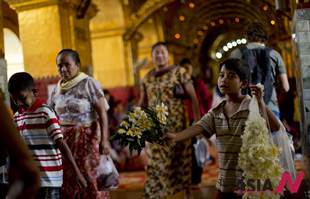Tourism in Mongolia: Quality or quantity?
 Gantemur Damba is president of the Mongolian Tourism Association and heads a large group of influential organizations important to the development of this country. He has worked as a consultant and project director for major international organizations. Until recently, he was General Director of the Culture and Art Policy Coordination Department of the Ministry of Education, Culture and Science. He studied and worked abroad for many years.
Gantemur Damba is president of the Mongolian Tourism Association and heads a large group of influential organizations important to the development of this country. He has worked as a consultant and project director for major international organizations. Until recently, he was General Director of the Culture and Art Policy Coordination Department of the Ministry of Education, Culture and Science. He studied and worked abroad for many years.
Anita Fahrni, with the Swiss Program for Language Instruction and Teacher Training, spoke with Gantemur about an industry in transition.
Having studied in several countries and traveled widely, you call yourself a “global nomad”. How has this affected your view of your homeland?
I am from Arkhangai, and am deeply rooted in Mongolian culture and Tibetan Buddhist philosophy. I know old Mongolian and Tibetan. The thinking and lifestyle of Mongolians today is very different from that of earlier times. Life here is no longer lived according to the virtues of the former Mongolian mentality. We have lost the very fundamental values of earlier societies, the qualities of virtue, knowledge, skills, and ethics. This is due only partially to external factors. It worries me that we have lost the competitive qualities necessary to face today’s economic challenges. These cultural questions affect everything we do.
As president of the Mongolian Tourism Association, is it your job to see that as many tourists as possible come to Mongolia?
The current government has published very ambitious figures, hoping to receive one million visitors in 2017 and four million per year by 2020. The numbers are presented without the government having studied the questions involved or having useable action plans. We need a clear picture of what Mongolia really is, of what it has to offer, of its competitive advantages, and of the expectations of potential tourists.
This is not Bali or Brazil. Ours is a specific niche market: high-end, specialized tourism for which we need improvements down the whole value chain. Quality rather than quantity! Lots of research was done earlier, for example by World Bank, extensive studies which few have ever read. One simply assumes that if no visa is required, Chinese and Russians will come! All tourists need quality service.
Tourism offers not only economic but also cultural and social opportunities. In order to provide good services to tourists, we must understand what foreigners want to do and to see, and integrate that into our offerings.
Where exactly do you see dangers to the quality of tourism here?
I see three major dangers. The first danger is a lack of security for investment in the tourism sector. Mongolia sells landscapes, both natural and cultural. Myths and narratives are very important. A quality tourist camp needs a landscape. If, suddenly, a cement block can be built next door, who will invest? Terelj is a good example of what has gone wrong.
I categorize places according to three M’s. The first M stands for modified places, basically spoiled. That includes Terelj, Kharkorum, and West Khuvsgul Lake, where there are 25 ger camps. In the second category are places which have been marginalized through bad planning. These are places like Dalanzagad and the Yoliin Am, or Bogd Khan Mountain. The third M is for the authentic, untouched Mongolia, which is what visitors want to see.
The second danger is the loss of this authenticity through our own lack of understanding of what we have to offer, what we have to sell.
The third danger is the lack of creativity. If we just make a copy of what we see elsewhere, creativity will always be lost, not understanding the intangible services needed to match the expectations of tourists. An example of the lack of creativity is the poor quality and poor design of felt slippers sold everywhere.
Can the uncontrolled spread of poorly built and badly maintained ger camps in locations that were once beautiful be stopped?
Basically, all tourists want to get out of Ulaanbaatar. They need the basics: a bed, a shower, and breakfast. Some want more comfort, some are content with less. Maximizing the number of beds is wrong. Rather, one should optimize amenities, offering landscapes of quality. Many camps have no business and could easily be dismantled. Trash management and wastewater management must be developed.
Even Mongolian tourists want to see nature and trees rather than cars and fences in front of their ger. Buffer zones around special spots and land use planning would lead to longer visits and more income for the local population.
Mongolia is seen as being a natural paradise, the Mongolians as being close to nature, the Earth being almost sacred to them. Travel agencies use this image to attract tourists. Are Mongolians still in touch with nature? Do they still respect the land?
Unfortunately, “development” is defined by many Mongolians as meaning “building”. One is moving away from nature, away from a creative economy based on natural resources and potential, building with bricks instead of building knowledge and skills. Maybe these concepts will be understood only after our mistakes become clear; our children will be left to undo what we have done badly. Now, most of them watch scenes in movies from Hollywood instead of enjoying the scenes of their spectacular homeland.
One would hope that all Mongolians could profit from tourism. That requires an appropriate infrastructure and the development of skills in fields such as visitor services, quality cultural presentations, the creation of well-designed souvenirs and foreign languages. Do you see these developments taking place?
You are right about those requirements. I speak of the need for quality in all actions and all sectors. My message is that many people talk very nicely about what is needed, agreeing politely about the situation, but then do the absolute opposite of what they have said. The desire for quality, for honesty and ethics, is lacking. Very little is actually done, no quality progress is made.
In spite of this lack of motivation for change, are you optimistic about the future of tourism in this very special country?
Very optimistic! Mongolia has truly deep and rich resources in the arts and culture, resources which are not being valued or presented at the moment. Creative and intelligent tourism policy and efficient management planning are all that is needed.
There is potential in Mongolia, not only for leisure tourism but also for MICE, which stands for Meetings, Incentives, Conferences, and Events. Mongolia has proven that it can organize major high-level meetings, supporting dialog among nations. One simply has to sell the location actively. Mongolia’s golden magic could help reduce current international tensions. We have the key to open up doors to world peace.




